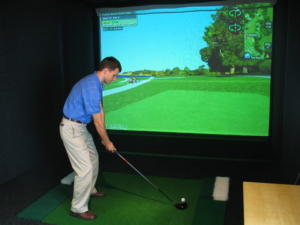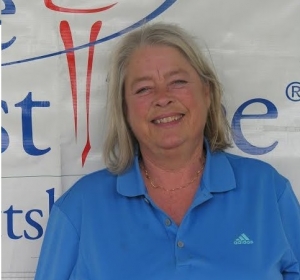After working for The First Tee of Pittsburgh for five years, I had reluctantly decided it was time to move on to other employment opportunities. The morning following this decision, my youngest son went missing. Two days later it was discovered that he had suffered a tragic death.
My world had stopped. I have very little memory of the months that followed. One day my phone rang and it was the program director from The First Tee asking me if I was planning to return to work. He asked if I would be interested in working with a group of vision impaired students. The offer peaked my interest and I thought this would be a nice opportunity.
All I knew was that I would meet with the students at an address that had previously been a hospital. At The First Tee we teach life skills through the game of golf. I gathered my lesson plan and my indoor equipment, which consisted of plastic snag clubs and tennis balls.
Once I arrived I investigated the space I would be using to teach. There was a very long hallway which was fortunately carpeted and a room that was full of tables and chairs. The person in charge arrived followed by fifteen young adults, most using canes that they held by, of all things, a golf grip.
My mind was racing, as this was not at all what I had expected. As we introduced ourselves I realized that these young people had little or no vision. Some were born blind, some had lost their vision in accidents and others were in the process of losing their vision. Clearly this group did not need me teaching them our core values of respect, courtesy and responsibility, to name a few. I knew the tables had turned. I took my lesson plan and promptly tossed it in the trash.
The equipment I brought was too small to use so we started by learning the athletic stance and how to grip the club. Very handy that they could use their canes. After class ended I knew that I had my work cut out for me. I stayed up most of the night doing research on blind golf.
The following week I returned with real putters and golf balls and we began the process of learning distance control in the long hallway. I was truly amazed at how well everyone knew measurement. I would also tap the wall so they could hear their target. By the end of this class I knew that we could do this. One of the students asked me with serious doubt, if I really thought I could teach them to golf. “Of course, I can”!
The weeks following, I brought my husband with me to assist. This was a great fit, as he also has limited vision due to an autoimmune disease. He connected with a young man who suffered from the same disease. Unfortunately, the treatment that he had received caused not only his blindness, but the loss of his eyes. Another young lady would spend most of the time asking us the color of things. We would do our best to describe color to her but wondered how to do this with someone who had never had sight. Another girl was blind and deaf. She was our most successful golfer.
It was time to teach the class how to hit full swing shots. There was no way we could do this in our usual space. We were fortunate to have the class transported to the golf course where we also had indoor simulators. The perfect space to teach the golf swing in a safe environment.

While doing research I learned that there were many blind golfers, associations and tournaments offered nationwide. These golfers followed USGA rules except for having a coach with them during the round to line up their shots and to describe the holes. I knew that I would need more help than just my husband.
I gathered a group of my junior league golfers and explained what was needed. If they were interested in working with the blind. I was offering a clinic to teach our Players how to be coaches of the blind golfers. We had a nice turn out of very skilled golfers and compassionate juniors attend. The first thing I did was blind folded each of the juniors and have them swing the club at various speeds so they would know how it effects balance. A slow swing could cause dizziness and loss of balance. They learned how to line up their golfers and to use the “all clear” signal to keep everyone safe.
Finally, it was time to go outside to play on the course. We started by using the putting green. Everyone was so excited to feel the soft short grass. This was also the first time the golfers were introduced to hills. They learned to feel the greens with their feet as they walked to establish an uphill, downhill or side hill lie. With the help of the coaches, the golfers quickly caught on and had great success with this part of the game.

On the last day of class, we went out on the course to hit full swing shots and to play a hole. What a special day for everyone. The students had been working with one of their coaches who had been with them for most of the clinics. They thought he was a girl because of his high voice and couldn’t believe that this was a young boy who had taught them so much.
The young man who asked me on the first day of class if I really thought that I could teach them golf gave me a hug and said, “I would have never believed it, but you did it”.
Near the end of class, we were gifted with one of the golf courses amazing sunsets behind the city. With excitement, many golfers asked us to describe the view as they felt the warmth against their faces. The young lady who had never had sight described the beauty of all the colors.
To top the evening off, the golfers were all treated to a ride in the golf cart. Only able to take a few at a time, it was quickly getting dark as we got to the end of the line. I said it would have to be a short ride because I could no longer see. One of the students spoke up and said, “that’s okay, we can drive”!
It has been close to eight years since this incredible experience. We taught them to golf and they taught us so many life skills and a tremendous appreciation for the many things we take for granted. To this day, I use many of the techniques I learned to work with them in my clinics with all my children. Our junior coaches are now college graduates.
The most significant thing to come from this experience was a personal one. It was the beginning of my grieving process and the realization that I am exactly where I should be.
Submitted by: Coach Leslie Russell, Northern Regional Manager
